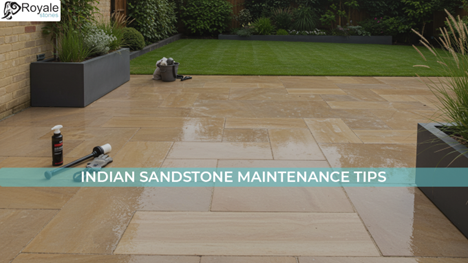If you have installed Indian sandstone paving slabs in your patio, pathway, and outdoor living areas, you cherish your space every time you see its natural beauty and rustic charm. You walk on them without worrying due to their durability. However, you cannot only rely on cleaning your sandstone pavement; you need to maintain it to preserve its structural integrity and look properly.
Maintaining Sandstone paving involves more than just cleaning the surface dirt; it requires regular sealing, inspections, minor repairs, and protective measures to prevent the slabs from breaking down or deteriorating. Think of it as your car; you need to have routine maintenance sessions with your mechanic to address issues and ensure its longevity, safety, and overall performance.
In this guide, we will walk you through Indian sandstone maintenance tips based on the UK’s weather conditions. We will cover:
- Regular Inspections
- Sealing the Surface
- Seasonal Cleaning Routine
- Prevent Moss and Algae Growth
- Joint Care
- Pressure Washing
- Damage Repairs
- Pro-Tip from Experts
- Long-term Maintenance
So, without further ado, let’s get into it.
Why is Indian Sandstone Maintenance Important
Indian Sandstones are natural and porous, which means that they are prone to absorbing water. As a spill-over effect, you see algae, lichen, stains, or frost damage if your Indian stones are not protected.
With proper maintenance, you can:
- Preserve Appearance: Retains the natural, vibrant tones and surface texture.
- Prevent Structural Damage: Stops cracks that are caused by frost or any loose joints.
- Enhance Safety: Reduces algae growth, which prevents slipping.
- Increase Lifespan: A well-maintained patio is able to last decades.
Pro-Tip: Royale Stones recommends combining the approaches of cleaning, sealing, and proactive care to ensure the durability of your India stone.
Indian Sandstone Maintenance Tips
Do more than clean your Indian Sandstone once you lay your sandstone slabs. From gentle cleaning, sealing, to regular inspection, you can apply numerous methods to keep them like new.
Regular Inspection
One of the basic maintenance tips is to simply look and observe your sandstone tiles. Check whether or not you have any loose slabs, cracks, or erosion of joints. Do this inspection at least twice a year.
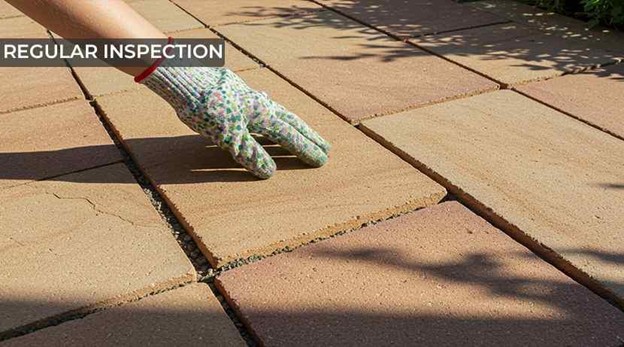
Also, look for early signs of green stains caused by moss or algae growth, especially in the shaded or damp areas.
Sandstone Sealing
One of the most effective ways of preserving and protecting your sandstone from staining and moisture penetration is by using Indian Sandstone sealer.
Why Seal Your Sandstone?
- It prevents algae and weed growth.
- Wet look sealers for sandstone give the surface a glossy, wet-look finish.
- Colour-enhancing sealer for sandstone deepens and enriches the natural colours
- It protects your slabs against frost and salt damage during the winter season.
- It makes cleaning paving slabs easier.
How Often Seal Indian Sandstone
You must reseal Indian sandstone slabs every 2 to 3 years. A high-quality breathable sealant protects Indian sandstone and preserves sandstone colour, unlike the non-breathable sealants that can trap moisture.
Pro-Tip: Use Royale Stone’s best sealer for Indian sandstone to retain your paving’s colour and protect it from moss and algae growth.
How to seal Indian sandstone?
- Read the Indian Sandstone sealer instructions properly.
- Do a test patch of sealer on sandstone in a corner of your outdoor space.
- Use sealer application tools (roller, brush, sprayer).
- Clean the sandstone before sealing.
- Apply sandstone sealer
Seasonal Cleaning Routine
Different seasons have different cleaning requirements during routine cleaning around spring and Autumn. Most UK homeowners make the mistake of cleaning sandstone with vinegar. No matter the season, avoid cleaning Indian sandstone with bleach, vinegar, harsh chemicals, acidic solutions, or cleaners as they can etch the surface and cause permanent damage.
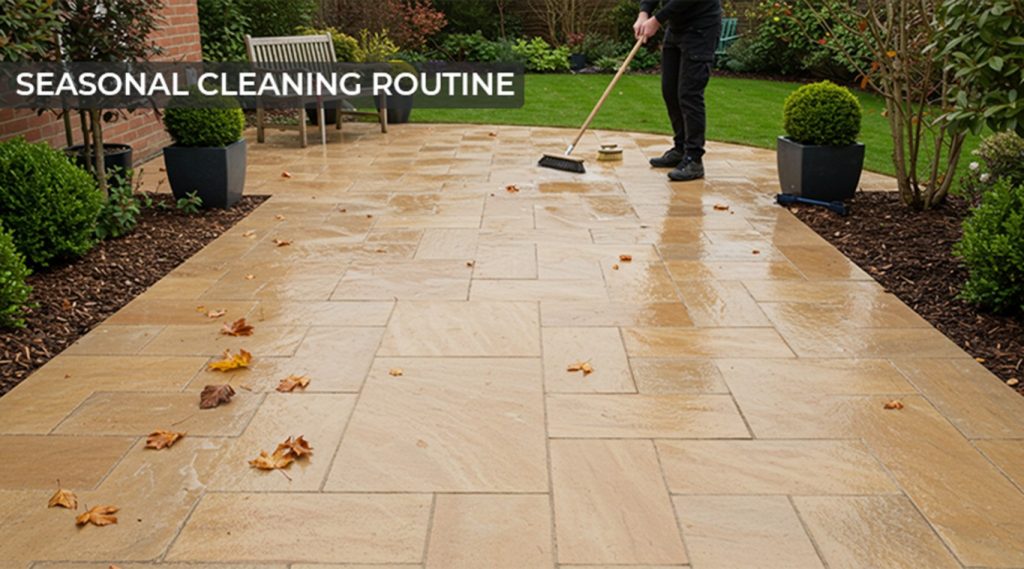
During spring, deep clean your outdoor Sandstone paving slabs with warm, soapy water and a stiff brush. While in autumn, remove fallen leaves promptly to avoid staining and lengthy washing processes.
Pro-Tip: Use Royale Stone’s best solution for cleaning Indian Sandstone to clean properly and keep it new.
Prevent Moss and Algae Growth
One of the most common problems in the UK is the damp weather conditions, which cause moss and algae growth on different surfaces outdoors, including your paving slabs.
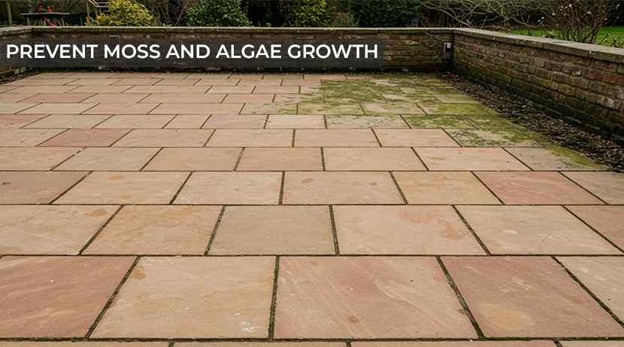
If you have Indian Sandstone installed in your patio or garden path, sweep regularly and use Indian Sandstone moss sealer so that you can prevent organic matter buildup over the surface or the joints of your slabs. If you want to be more meticulous and have stubborn green patches in your patio slabs, use a pH-neutral algae remover to remove them gently.
Joint Care
You not only have to ensure the surface of your Indian Sandstone pavers, but also inspect your paving slab edges and joints. If you do not, the loose joints might allow weed and water ingress, accelerating damage. Repair and repoint joints with appropriate mortar if you see gaps between your slabs.
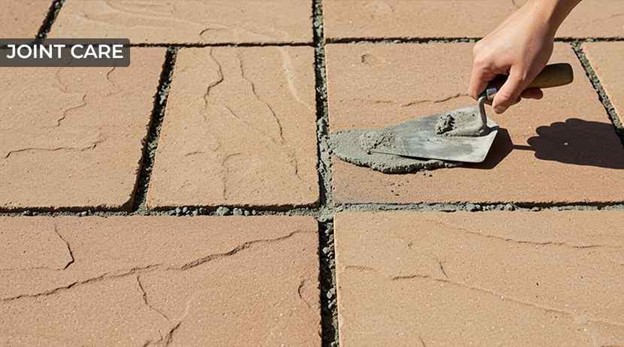
Pressure Washing
If you are pressure washing your Indian Sandstone paving slabs, DO NOT pressure wash them excessively. High-pressure washing can strip the surface of your stone slabs and damage the joints.
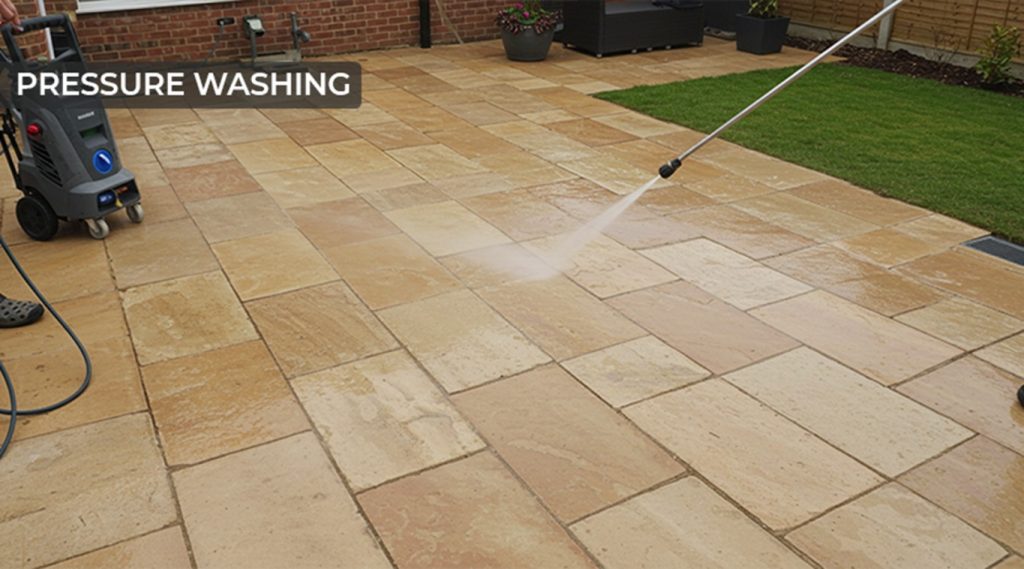
If you must use one, choose a fan spray setting, not a direct jet. While pressure washing sandstone, keep your nozzle 12 inches away from the paving surface.
Damage Repairs
If you see a hairline crack or any chip around the edges of your Indian sandstone patios, fix it as early as possible. This will help you prevent water penetration and frost damage in the early stage without causing long-term damage.
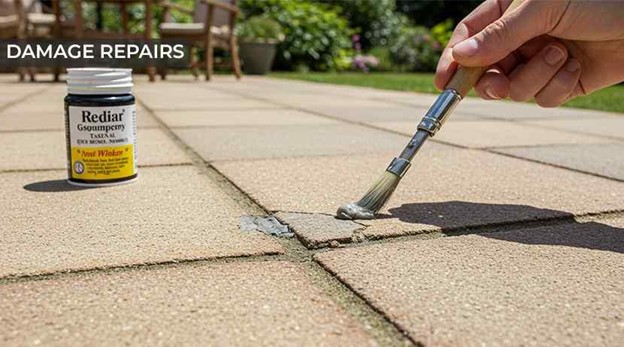
Pro-Tip from the Experts
Industry experts suggest that you must combine daily checks, gentle cleaning, and sealing for a complete maintenance strategy. In short, do not rely only on cosmetic cleaning and apply all the maintenance tips to increase sandstone’s lifespan.
Pro-Tip: These maintenance tips are especially crucial when you have laid Kandla Grey Sandstone or Raj Green Indian Sandstone, as they are expensive to replace and need great care and upkeep.
Long-term Maintenance
Your maintenance schedule must be based on the weather conditions. Clean and do your maintenance tasks with the following frequency:
- Sweep and Rinse: Weekly
- Check Joints and Cracks: Every 6 months
- Deep Clean: Twice a year.
- Seal: After every 2 to 3 years.
Final Thoughts
When it comes to Indian Sandstone maintenance tips, you need to do more than just sandstone cleaning. You have to take good care of these porous natural stone pavings to ensure that they maintain their durability and longevity without any worries.
Royale Stones provides a wide variety of paving slabs, including Indian Sandstone paving, gentle cleaners, and patio sealer for sandstones to provide you with freedom from paying constant attention to your patio. Instead, let’s you focus on more important things in your life, like living it to the fullest!
Frequently Asked Questions
Q: How to maintain Indian sandstone?
A: Sweep regularly, do your seasonal cleaning, seal after every few years, and monitor your paving area for any cracks or loose joints to maintain your Sandstone paving properly.
Q: Is Indian sandstone high maintenance?
A: No. Indian Sandstone requires low to moderate maintenance. Simple cleaning, sealing, and occasional repairs can do the job for you, keeping it in great condition.
Q: Is it a good idea to seal Indian sandstone?
A: Yes. Sealing helps your sandstone remain durable, prevents it from staining, and reduces algae and moss growth.
Q: Should you pressure wash Indian sandstone?
A: Yes, but be cautious. Use a low-pressure setting and maintain a safe distance to avoid damaging the surface of your paving or your joints.
Q: Can you use washing-up liquid on Indian sandstone?
A: Yes, if the washing up is mild. Mix it with warm water and clean the surface for routine cleaning. Avoid using harsh chemicals or acidic cleaners.
Q: How to polish Indian Sandstone?
A: Clean the surface with a mild stone cleaner and remove stains and dirt. Use a fine-grit sandpaper to smooth the surface and rub in a circular motion. Apply a stone polishing powder or paste and buff with a soft cloth or machine polisher. Seal the sandstone with high-quality natural stone sealer for colour enhancement and natural tone protection.
